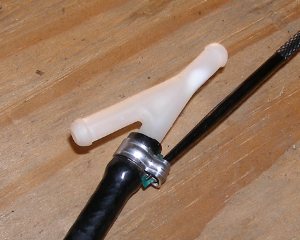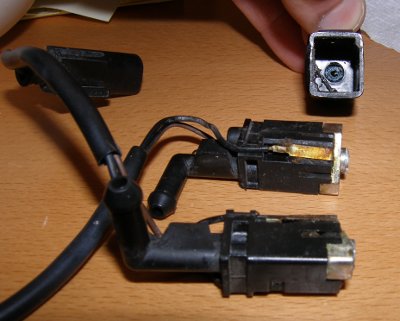Saturday, January 9, 2010
Visit with Technician
 I dropped by the dealer earlier today to ask
one of the technicians what kind
of tool they use to fasten the special miniature band clamps used to secure
the various connections in the windshield washer system. As I walked into the
maintenance area I was pleasantly surprised to find my technician in his bay
working. Since he's the lead in the shop he doesn't typically work weekends
so I was naturally curious as to why he was spending one of his few days off
screwing around with BMWs. It turned out he was doing a simple
valve
cover gasket replacement on his own car. I interrupted his work long enough
to show him the crimp-type clamp and he kindly explained that contrary to their
appearance the clamps are not designed to be permanently crimped like some
of the other factory band clamps. He used a pair of diagonal cutters to pull
the mating surfaces together until they snapped closed, then inserted
a straight pick between the two mating surfaces and twisted it just enough
to slide them sideways as required to open the clamp.
I dropped by the dealer earlier today to ask
one of the technicians what kind
of tool they use to fasten the special miniature band clamps used to secure
the various connections in the windshield washer system. As I walked into the
maintenance area I was pleasantly surprised to find my technician in his bay
working. Since he's the lead in the shop he doesn't typically work weekends
so I was naturally curious as to why he was spending one of his few days off
screwing around with BMWs. It turned out he was doing a simple
valve
cover gasket replacement on his own car. I interrupted his work long enough
to show him the crimp-type clamp and he kindly explained that contrary to their
appearance the clamps are not designed to be permanently crimped like some
of the other factory band clamps. He used a pair of diagonal cutters to pull
the mating surfaces together until they snapped closed, then inserted
a straight pick between the two mating surfaces and twisted it just enough
to slide them sideways as required to open the clamp.
With that small task out of the way my attention naturally gravitated to a nearby bay in which two N52 blocks in various states of disassembly were located on engine stands. This was the first time I'd seen any BMW bottom end fully disassembled (close up, anyway) and took a few minutes to look around. When I asked what was wrong with the block my technician pointed out that BMW now uses a combination of aluminum and magnesium to construct their blocks to save weight. The magnesium wraps an inner core made of aluminum for compatibility with engine coolant. Problem is some of these engines have started to experience leaks in certain locations where the two metals meet. This led to a discussion on the current quality of BMW engines, to which my technician responded (paraphrased) that the E36 and E46 engines (M52 and M54) are more or less bullet proof due to their relative simplicity, but the newer N52 and N54 engines are showing signs of technology failures (like this manufacturing technology defect, turbo failures, etc.) that may affect the long term reliability of the engines. He was quick to point out that the block leak issue is very rare so it's likely but a blip in the data for BMW, but I took this as another sign that it sucks to be on the bleeding edge. I'll take the old and proven systems, thanks.
I also noticed that the new block had been fitted with new stock pistons equipped with sizeable valve reliefs. That prompted me to ask if the engine was still considered an "interference engine" and he responded in the affirmative. Lose that timing chain and you're going to bend valves. But fortunately -- at least for now -- BMW wisely continues to use a chain rather than a belt and the chains still appear to be designed to last the useful life of the engine (250K+ miles in the case of the M52 / M54). Of course, no one knows how long the new turbo motors will run as they haven't been around long enough. They may be able to meet the same lofty goals as the older engines in spite of BMW's "war on maintenance" (15K oil changes, "lifetime" fluids, etc.) but we won't know for many years.
Windshield Washer System Overhaul
I received the parts necessary to repair the leaking windshield washer jet this week and completed the repair today. I also managed to overhaul the system and through the installation of a new thermostatic switch, fluid pump and hose. The temperature was hovering in the 20's by the time I got out to the garage so I fired up the kerosene heater and got to work. I'm not sure if this work warrants a DIY but if it does I'll post it later. In the interim I'll simply point out what I learned.
 I determined that the leak in passenger side
jet was due to metal corrosion rather than the heating elements. This
jives with my earlier findings in that both nozzles appeared to melt the snow
I placed over them. I did not discover the cause of the leak until I disassembled
the old jets. The jet is in fact two pieces:
an inner metal section to which the heating
elements are connected and an external plastic shell that contains the
part of the jet visible from the top of the hood including the two small
jets that direct fluid to specific areas of the windshield. The inner section
contains a single orifice that protrudes beyond its top face by
about 1/8". This raised orifice fits into a corresponding cup of the
same depth in the outer shell. Metal corrosion caused erosion of the face
of the inner jet which resulted in a loose fit (thus a leak) between
the interior jet and the external shell. Since the interface between the
two sections is also responsible for heat transfer to the outer jets I now
know why the leaking jet seemed to take longer to melt the snow.
I determined that the leak in passenger side
jet was due to metal corrosion rather than the heating elements. This
jives with my earlier findings in that both nozzles appeared to melt the snow
I placed over them. I did not discover the cause of the leak until I disassembled
the old jets. The jet is in fact two pieces:
an inner metal section to which the heating
elements are connected and an external plastic shell that contains the
part of the jet visible from the top of the hood including the two small
jets that direct fluid to specific areas of the windshield. The inner section
contains a single orifice that protrudes beyond its top face by
about 1/8". This raised orifice fits into a corresponding cup of the
same depth in the outer shell. Metal corrosion caused erosion of the face
of the inner jet which resulted in a loose fit (thus a leak) between
the interior jet and the external shell. Since the interface between the
two sections is also responsible for heat transfer to the outer jets I now
know why the leaking jet seemed to take longer to melt the snow.
While I didn't notice any operational problems with the driver's side jet I replaced it along with the leaking jet and noticed a much stronger and finer stream of washer fluid exiting the new jets. Substantial corrosion was found in the driver's side (working) jet but it obviously hadn't progressed as far as in the leaking jet. This means the driver's jet was likely to fail at some point in the near future so I made the right call to replace both jets. I imagine this is quite typical for these parts so in my opinion they should be replaced in pairs.
The fluid flows from the fluid pump through a single line to a Y fitting. The outputs of the Y fitting go to each jet. Since the washer fluid bottle and pump are on the right side of the car the passenger jet is connected through a small 4" section of hose and the driver's side is connected with a section that is slightly under three feet long. The piece I received with my parts order was 4 feet long so after cutting the necessary sections I was left with a spare piece about 8 inches long. I'm glad I replaced the hose because the old hose sections had hardened due to age and were not sealing well. I partially deformed the Y fitting during disassembly (the stressed area is recognized by its milky-white appearance in the picture) so I'm also glad I bought extras of that part as well.
Contrary to what the ETK (parts book) implied, no check valves are used in this system so I wasted a few dollars on those parts. Unfortunate, but unavoidable, as I had no idea whether the valves were hidden somewhere and wasn't about to disassemble everything earlier without the needed parts on hand. This isn't the first time this has happened and it won't be the last.
The new fluid pump is noticeably quieter than the original pump but that's about the only operational difference. I could have easily avoided replacement of the pump but I decided to file this under "preventative maintenance". I replaced the thermostatic switch for the same reason. Imagine spending $70+ on new nozzles only to have the switch fail and the nozzles freeze and crack. Replacement of the switch required removal of the passenger side protective panel under the bumper cover. No jacking of the front end was required to facilitiate access to it.
I found the special band clamps to be a bit temperamental. Some persuasion with the flat side of a pair of lineman's pliers were needed to bend the outer band down so it would grab onto the inner band sufficiently. I was careful doing this so as to not damage the brittle plastic fittings.
The last snafu of the day came when I attempted to replace the underhood insulation fasteners with the new parts: they didn't fit into the corresponding holes in the hood. I salvaged enough of the old fasteners to secure the insulation for the time being but I'm planning to bring the correct part to my local dealer and order a new set from them.
The job took about three hours of my day but that had a lot to do with my lack of familiarity with the various parts, my lack of interest in moving fast in the cold weather, and chatting with my brother. I estimate I could do the job again in an hour and a half. However, I think the job would be worth 2 hours of labor from the dealer simply because replacement of each item would likely add up to more than that due to book labor charges. So I'll call it two hours of labor saved or $256.
Mileage: 187050, Parts $157, Labor Saved: $256



